Net Zero Carbon Supplementary Planning Document
Policy NZC1 states that:
New developments of one or more dwellings (C3 or C4 use class) and/or 1,000sqm or more of new non-residential floorspace, hotels (C1) or residential institutions (C2 use class) should achieve net zero operational regulated carbon emissions by implementing the energy hierarchy.
Part 1 of this Energy Pro-Forma must be completed for all applications as set out above to demonstrate compliance with policy requirements of NZC1, NZC2A-C and NZC3. For residential development please complete 1A, for non-domestic development please complete 1B.
For developments where repeated house typologies are being used, or where multiple non-domestic buildings are being proposed, the applicant can apply an aggregated average of carbon emissions across these typologies or building types. The tables below indicate where aggregated data should be input if being used, otherwise please complete each table according to the proposed dwelling(s) or building(s) being proposed.
A separate Energy Pro-Forma has been prepared for Existing Buildings (householder, extensions and conversions) to demonstrate compliance with NZC4. This is set out in Part 2.
Annex Part 1: New Build Development
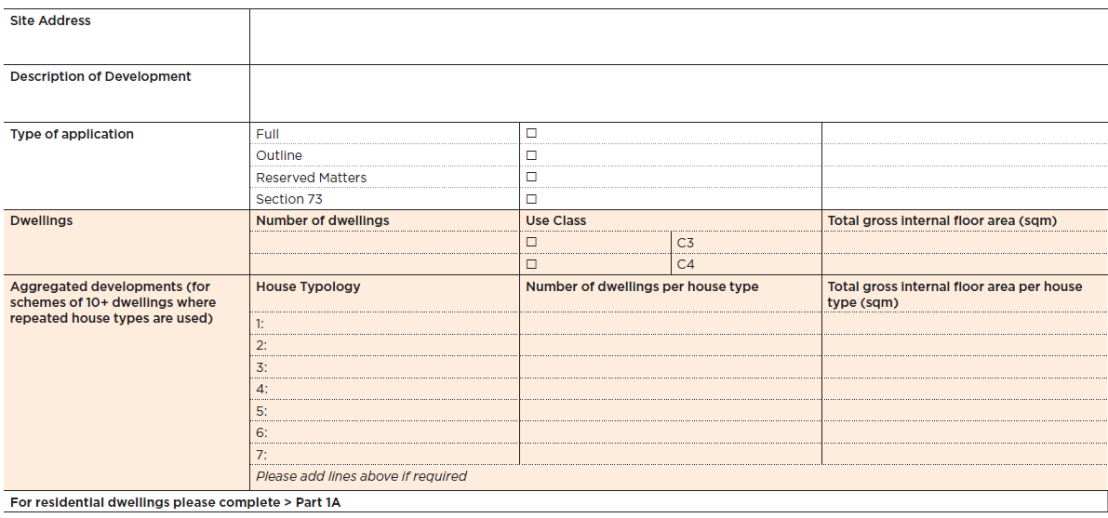
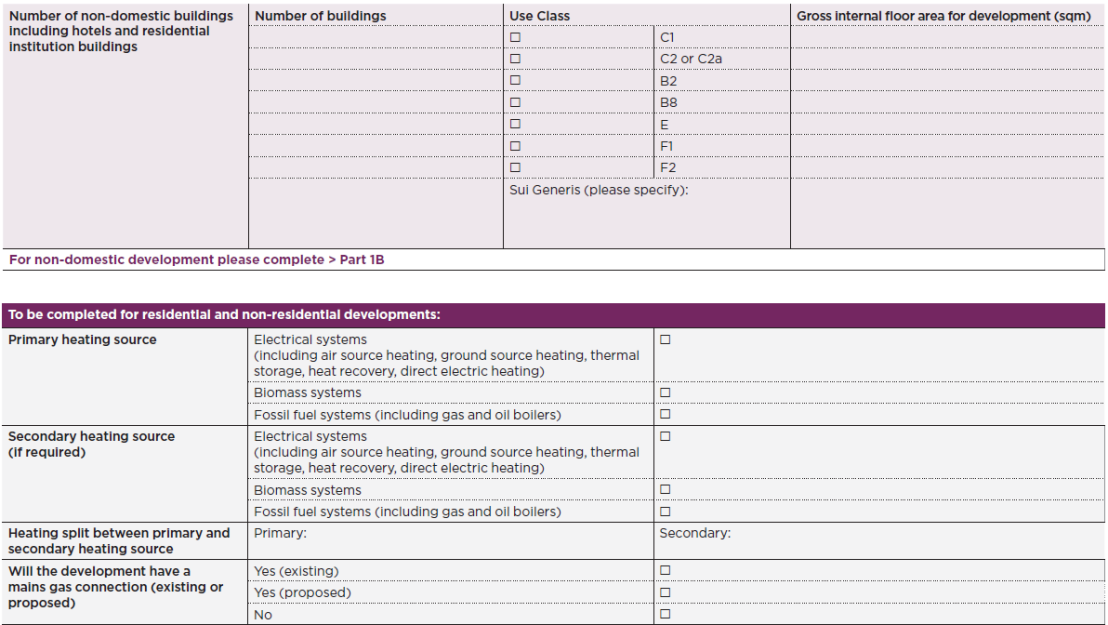
Download the PDF Annex Part 1: New Build Development Form
Part 1A – Residential Dwellings
NZC1: The overall % carbon emissions reduction against Building Regulations
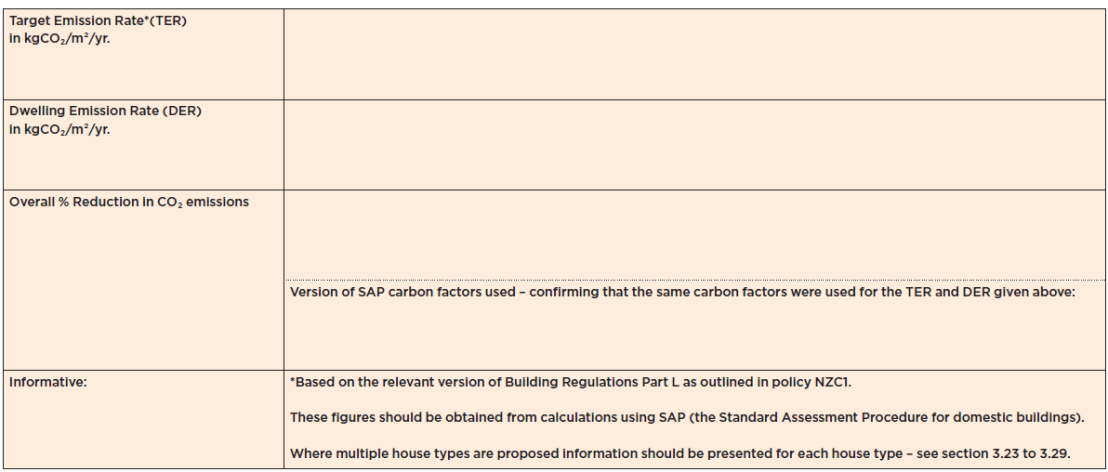
Download the PDF Part 1A – Residential Dwellings, NZC1: The overall % carbon emissions reduction against Building Regulations form
Energy Hierarchy Stage 1
NZC2(A): % improvement of energy efficiency against Building Regulations
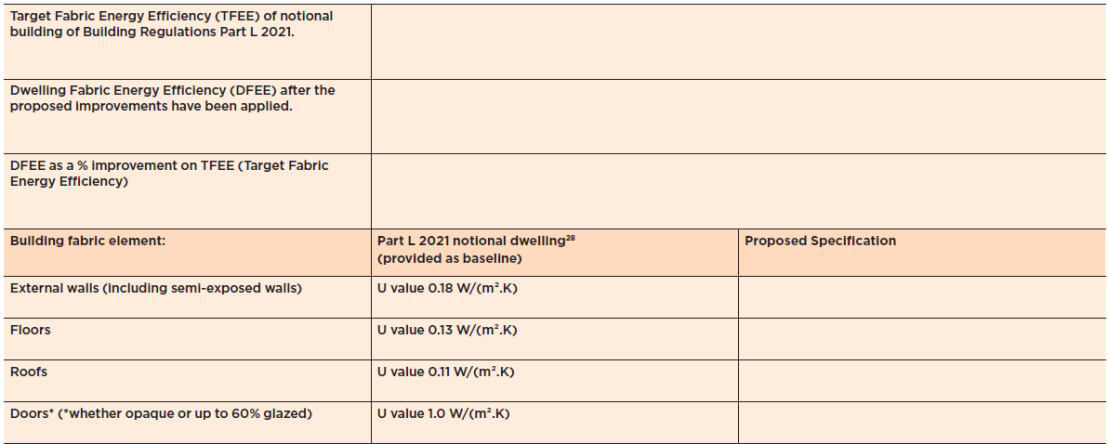
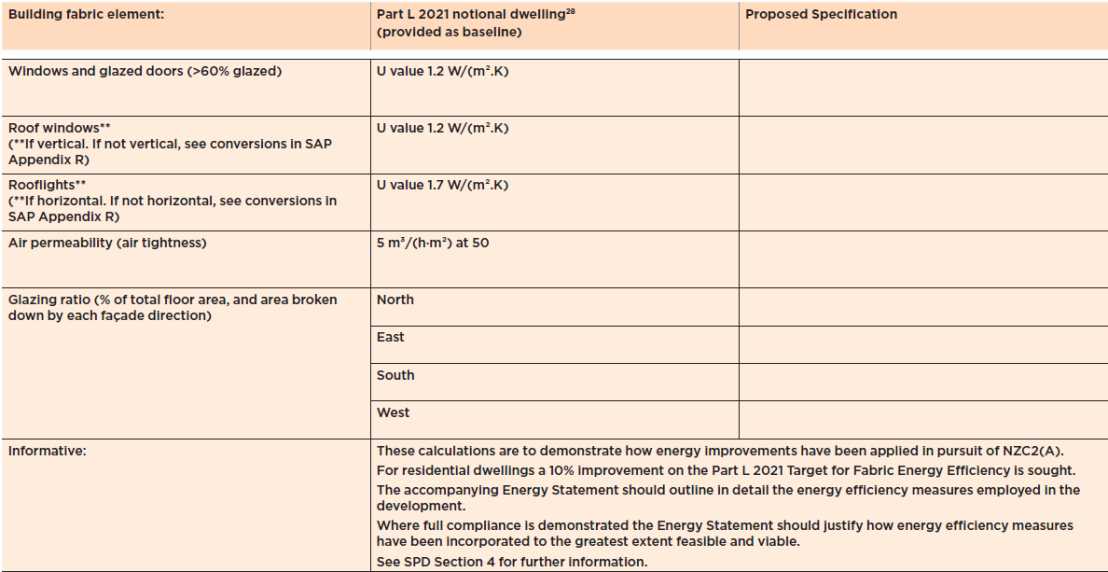
Download the PDF Part 1A - Residential Dwellings, Energy Hierarchy Stage 1, NZC2(A): % improvement of energy efficiency against Building Regulations Form
Energy Hierarchy Stage 2
NZC2(B): kWh of energy generated onsite through zero or low carbon energy sources, and regulated carbon emissions reduction as a result of this.
|
Residential Target Emission Rate (TER) of the notional dwelling of Part L 2021 |
|
|
Version of SAP version carbon factors used: |
|
|
Dwelling Emission Rate (DER) after NZC2(A) energy efficiency measures have been applied. |
|
|
DER after renewable and low carbon energy measures towards NZC2(B) have been applied, subsequent to the improvement made by measures under NZC2(A). |
|
|
Version of SAP version carbon factors used: |
|
|
Actual % improvement on TER as a result of renewable and low carbon energy measures |
|
|
Informative: |
These calculations are to demonstrate how zero or low carbon energy generation technologies have been applied in pursuit of achieving on-site net zero operational carbon (regulated energy). The accompanying Energy Statement should include an assessment of renewable and low carbon technologies and the specification of the technologies employed. Where on-site net zero regulated carbon is not demonstrated the Energy Statement should demonstrate and justify that zero or low carbon technologies have been provided to the greatest extent feasible and viable. See SPD Section 5 for further information. |
Energy Hierarchy Stage 3
NZC2(C): residual carbon emissions are offset
|
DER after all on site measures (NZC2A+B) have been applied in kgCO₂/m²/yr. |
|
|
For aggregated developments using repeated house types, the average across all residential development, weighted by amount of GIA created by different residential typologies and orientations: |
|
|
Residual regulated carbon emissions per dwelling kgCO₂/yr |
|
|
For aggregated developments using repeated house types, the total across all residential development: average DER x residential total GIA: |
|
|
Converted to tonnes CO₂/yr. |
|
|
Total residual carbon emissions across 30 years tonnes CO₂/year X 30 years (Static offset) |
|
|
BEIS Carbon Value £ tonneCO₂ |
|
|
Total carbon emissions x BEIS carbon value |
|
|
Total Offset Figure for residential dwellings (Static offset) |
£ |
|
Dynamic Offset Option for total regulated carbon emissions over 30 years in tonnes CO₂ To be used in all-electric proposal only. Applying BEIS projected grid carbon reductions. See SPD Section 6. Informative: |
See SPD Section 6 for further information. If it is not considered viable to make the offsetting contribution in full or part please see Net Zero Carbon DPD Section 11 for Viability guidance. |
Download the PDF Part1A - Residential Dwellings, Energy Hierarchy Stage 3, NZC2(C): residual carbon emissions are offset form
Part 1B – Non-domestic Buildings
NZC1: The overall % carbon emissions reduction against Building Regulations
|
Target Emission Rate*(TER) in kgCO₂/m²/yr. |
|
|
Dwelling Emission Rate (DER) in kgCO₂/m²/yr. |
|
|
Overall % Reduction in CO₂ emissions |
|
|
Version of SBEM carbon factors used – confirming that the same carbon factors were used for the TER and BER given above: |
|
|
Informative: |
*Based on the relevant version of Building Regulations Part L as outlined in policy NZC1. These figures should be obtained from calculations using SBEM (the Simplified Building Energy Model for non-domestic buildings) |
Download the PDF Energy Hierarchy Stage 1: NZC2(A) - Non-domestic Buildings Form
Energy Hierarchy Stage 1
NZC2(A): % improvement of energy efficiency against Building Regulations
|
TER of notional building using Part L 2013 specification |
|
|
Version of SBEM carbon factors used: |
|
|
Optional: TER of notional building using Part L 2021 specification, and version of SBEM carbon factors used |
|
|
Version of SBEM carbon factors used: |
|
|
BER after all energy efficiency improvements (including fabric) have been applied. Excluding any renewable/low carbon energy measures |
|
|
Version of SBEM carbon factors used: |
|
|
BER after all energy efficiency improvements (including fabric) have been applied. Excluding any renewable/low carbon energy measures |
|
|
Version of SBEM carbon factors used: |
|
|
BER % improvement on TER as a result of energy efficiency improvements Exclude any renewable energy measures. |
|
Building Specification |
Notional Spec (baseline) |
Proposed Specification |
|
External walls (inc. semi exposed walls) |
||
|
Floors |
||
|
Roofs |
||
|
Doors (opaque or semi glazed) |
||
|
Windows and glazed doors |
||
|
Rood windows |
||
|
Rooflights |
||
|
Efficiencies of building services |
||
|
Air permeability (air tightness) |
||
|
Glazing ratio (% of total floor area, and area broken down by each façade direction) |
North |
|
|
East |
||
|
South |
||
|
West |
||
|
Optional: Building Primary Energy Rate as a % improvement on Part L Target Primary Energy Rate. |
||
|
Informative: |
These calculations are to demonstrate how energy improvements have been applied in pursuit of NZC2(A). For non-residential buildings a 19% reduction in carbon emissions compared to Part L 2013 is sought through energy efficiency measures. The accompanying Energy Statement should outline in detail the energy efficiency measures employed in the development. Where full compliance is not demonstrated the Energy Statement should demonstrate how energy efficiency measures have been incorporated to the greatest extent feasible or viable. See SPD Section 4 for further information. |
|
Download the PDF Part 1B - Non-domestic Buildings, Energy Hierarchy Stage 1, NZC2(A): % improvement of energy efficiency against Building Regulations form
Energy Hierarchy Stage 2
NZC2(B): kWh of energy generated onsite through zero or low carbon energy sources, and regulated carbon emissions reduction as a result of this
|
Building Emission Rate (BER) after NZC2(A) energy efficiency measures have been applied. |
|
|
Version of SBEM carbon factors used: |
|
|
Building Emission Rate (BER) after renewable and low carbon energy measures towards NZC2(B) have been applied, subsequent to the improvement made by measures under NZC2(A). |
|
|
Actual % improvement on non-residential TER as a result of renewable and low carbon energy measures |
|
|
Informative: |
These calculations are to demonstrate how zero or low carbon energy generation technologies have been applied in pursuit of achieving on-site net zero operational carbon (regulated energy). The accompanying Energy Statement should include an assessment of renewable and low carbon technologies and the specification of the technologies employed. Where on-site net zero regulated carbon is not demonstrated the Energy Statement should demonstrate and justify that zero or low carbon technologies have been provided to the greatest extent feasible and viable. See SPD Section 5 for further information. |
Energy Hierarchy Stage 3
NZC2(C): residual carbon emissions are offset
|
BER after all on site measures (NZC2A+B) have been applied in kgCO₂/m²/yr. |
|
|
For aggregated development, the average amount of GIA proposed per non-residential building typology or use: |
|
|
Residual regulated carbon emissions per building kgCO₂/yr |
|
|
For aggregated development, the average BER x the total non-residential GIA: |
|
|
Converted to tonnes CO₂/yr. |
|
|
Total residual carbon emissions across 30 years tonnes CO₂/year X 30 years (Static offset) |
|
|
BEIS Carbon Value £ tonne CO₂ |
|
|
Total carbon emissions x BEIS carbon value |
|
|
Total Offset Figure (static offset) |
£ |
|
Dynamic Offset Option for total regulated carbon emissions over 30 years in tonnes CO₂ To be used in all-electric proposal only. Applying BEIS projected grid carbon reductions. See SPD Section 6. |
|
|
Informative: |
This calculates the total carbon offset amount by taking the residual amount of carbon emissions from the building over a 30 year period. Applicants can apply BEIS projected grid carbon reductions should they wish providing they indicate the source of these projections, and providing this future grid carbon reduction is not applied to types of energy use to which the projections do not apply e.g., fossil fuels. See SPD Section 6 for further information. If it is not considered viable to make the offsetting contribution in full or part please see Net Zero Carbon DPD Section 11 for Viability guidance. |
Download the PDF Part 1B - Non-domestic Buildings, Energy Hierarchy Stage 3, NZC2(C): residual carbon emissions offset form
Annex Part 2: Existing Buildings
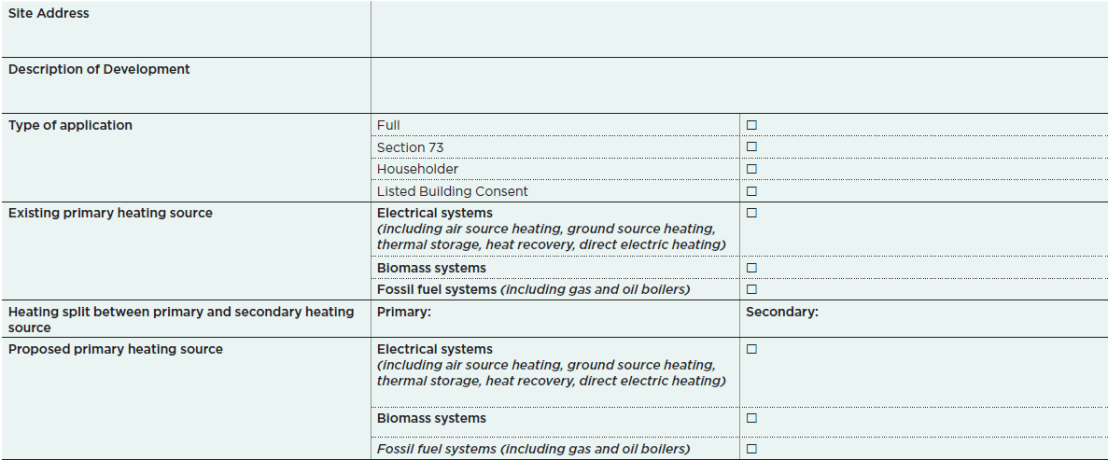
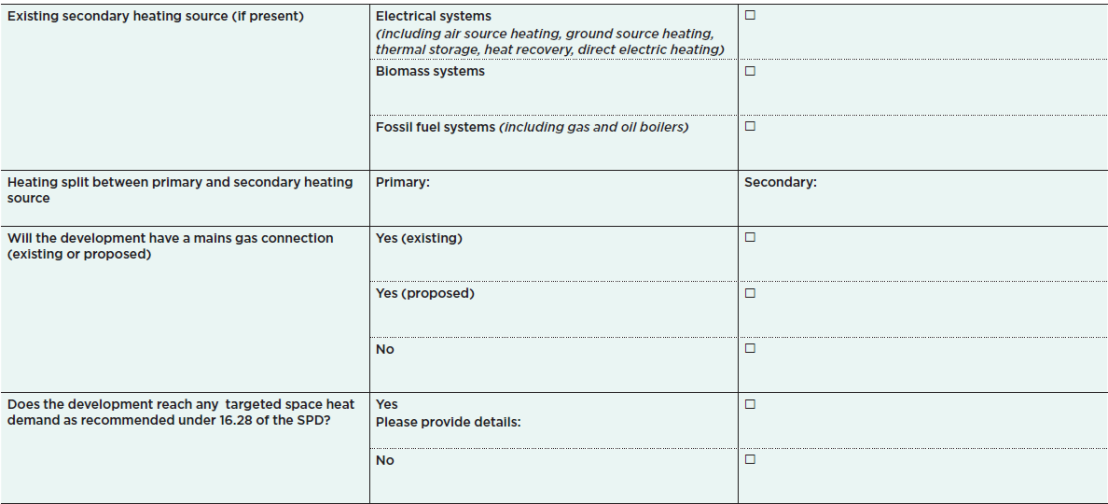
Download the PDF Annex Part 2: Existing Buildings form

28HM Government Department for Levelling Up, Housing and Communities and Ministry of Housing, Communities & Local Government (2023) Building Regulations Part L (“Conservation of Fuel and Power Approved Document L) 2021 edition incorporating 2023 amendments. https://assets.publishing.service.gov.uk/government/uploads/system/uploads/attachment_data/file/1133079/Approved_Document_L__Conservation_of_fuel_and_power__Volume_1_Dwellings__2021_edition_incorporating_2023_amendments.pdf